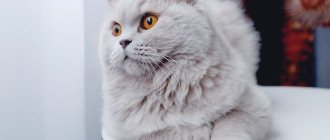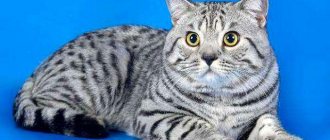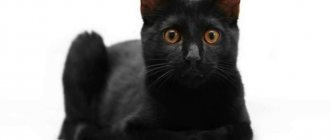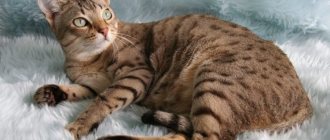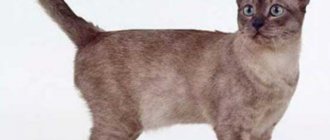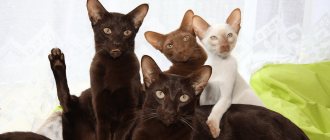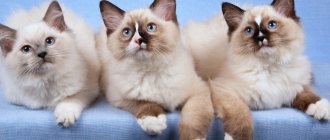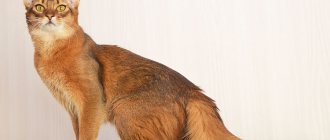If you need a companion in all household chores, then the best option of all is definitely the Burmese cat! It’s not for nothing that this breed is compared to a dog and is even called a cat with a dog’s character.
Of course, she won’t clean up the house for you or bake pies or make dumplings, but she will be next to you. Therefore, you can safely place a chair when preparing lunch or dinner, and the Burmese will support you with their presence throughout the entire process.
Before you decide to bring a Burmese cat into your home, we advise you to learn more about the breed from our detailed review with an assessment of characteristics.
Conditions of detention
Such a pet definitely needs company, otherwise you risk one day getting a destroyed house.
Like any shorthaired dog, she is afraid of drafts and catches colds easily.
It is necessary to ensure that she does not leave to study the world around her, since due to her insatiable thirst for research, this animal can sneak out the door unnoticed.Keeping a pet
Keeping Burmese cats is not difficult, but requires knowledge of some features.
Nutrition
The quality of Burmese wool directly depends on the quality of food
The Burmese cat is not particularly picky about food, but the owner needs to know that it plays an important role in maintaining the health and activity of the cat, and also directly affects the lifespan of the graceful pet.
Quantity and composition of food
It is possible to provide food for a Burmese cat with both natural food and ready-made dry or canned food of high quality, that is, super premium class.
When feeding ready-made dry food, you should strictly follow the instructions on the packaging, measuring the recommended amount of food using a scale.
If the owner prefers to use canned food, usually one jar (80–100 grams) contains one serving of food.
Breeders and experienced Burmese owners recommend the following food for this breed:
- Pro Plan;
- Hill's;
- Eukanuba;
- Bozita;
- Nutro Choice;
- Iams;
- Innova Evo.
Quality cat food
Natural nutrition requires more time for preparation, variety in the diet and additional vitamin supplements. The basis of the diet is necessarily raw dietary meat, served to the pet after freezing and subsequent scalding with boiling water. A cat consumes 80–100 grams of meat per day, this is 80% of the total amount of food for the day. Dietary types of meat include white poultry meat, rabbit meat, beef and veal, as well as offal of these same animals. It is possible to include exclusively sea fish in the diet and no more than once a week.
You need to give your pet fermented milk products, hard-boiled egg yolk (no more than 2 pieces per week), fresh vegetables and herbs. These products make up the remaining 20% of the total food, their total weight can be about 20 grams.
There should always be a sufficient amount of clean drinking water available to the animal.
How many times a day should you feed your pet?
An adult cat is usually fed twice a day; no additional feeding is required. If the animal has not eaten its portion within half an hour, the food is removed until the next meal. This is how the pet gets accustomed to the correct diet.
Kittens are usually fed at least four times a day until about sixteen weeks of age, then they are transferred to three meals a day, and by the age of one year the baby can already eat 2 times a day.
The role of a balanced diet in cat health
It must be remembered that diet directly affects the health and beauty of the cat. With a properly selected and balanced diet, the cat remains active, its fur shimmers beautifully. If the coat becomes dull (and in the Burmese this becomes noticeable quickly), then the diet should be reconsidered. You may need to consult a veterinarian and then select a different food or create a new diet.
Appearance care
Caring for a Burmese cat is not difficult, the main thing is to follow certain rules, then the beauty with oriental notes in her appearance will delight you with her beauty every day.
Brushing and bathing
The coat is short and close to the body and does not require special care. It is enough to comb your pet once a week using a special brush with small silicone spikes; twice a month you can comb it with a special comb for animals - a furminator with the smallest tooth size. During molting, increase the number of combings to 2-3 per week.
Burmese are bathed only when they become dirty or in preparation for an exhibition. Shampoos are used specifically designed for animals, with mink oil or cocoa butter.
High quality grooming for pets
Other beauty tips
Once every two weeks, the Burmese needs to cut its claws with special scissors, and the kitten must be accustomed to this procedure from an early age. You should also examine your pet’s ears once a week and, if necessary, clean them using special lotions or solutions.
If your cat's eyes are sour and it is not permanent, you can wipe the eyes with a decoction of chamomile or tea.
Buying the necessary things for a kitten
Before a Burmese kitten appears in the house, you need to prepare for its reception, purchase the necessary dishes for the baby (one bowl for food, the second for water), a tray where the baby will relieve his natural needs, toys and a scratching post.
Burmese cats are very active, and toys allow them to channel their energy in the right direction. All kinds of balls, balls with an elastic band, feathers on a stick, mice will be a success during games.
A scratching post for Burmese is a necessary accessory, as these cats love to scratch their claws. If your pet does not have a special place for this activity, she will designate it for herself, but the upholstered furniture will suffer greatly.
When choosing a tray, you should know that Burmese love to row behind them. Therefore, a tray with a grid will not suit them. For this breed, it is better to choose a high pot with a side or a covered house.
But Burmese cats do not have any special requirements for the type of filler; they are happy to use silica gel, bentonite or pressed sawdust.
Such a deep tray is quite suitable for a Burmese cat
Burmese people walking on the street
The Burmese cat does not need a special walk; it can quite easily not leave the apartment. But if the owners themselves want to walk the cat on the street, then they should accustom it to this from an early age. At the same time, walks can only be done in the warm season, since Burmese do not like frosts and drafts, and the temperature-dependent color will begin to darken when walked in sub-zero temperatures.
It is imperative to walk a Burmese cat on a harness, since the curiosity of this breed practically knows no bounds, and the pet can get lost while chasing an object that interests it.
Free range is not recommended for this breed
Care
Brush with a rubber and then a suede glove a couple of times a week to ensure the silky coat shines brightly. She is very clean and requires constant care of the tray. She does not agree to cleaning the tray once a day.
Read here British Longhair cat: character of the breed, care features and tips for choosing a purebred cat (95 photos)
Photo gallery: Burmese cat
These cats are incredibly beautiful
They don't like loneliness
Burmese are sociable, but unobtrusive
Get along well with other pets
Burma is a caring mother
The curiosity of cats of this breed knows no bounds.
Breed Features
Very attached to the owner. She is ready to sit on her owner’s lap, shoulders and head, just to be closer to him.
Like all oriental cats, it has outstanding intelligence, and therefore is well trained.
Description of the Burmese breed
Burmese are so unique that it is almost impossible to confuse them with other breeds. They outwardly resemble graceful pumas, but at the same time they are distinguished by their amiable character and playful disposition, which persists into adulthood.
Appearance: coat color and thickness, eye color, anatomical features
Despite the differences in the appearance of the American and European Burmese, the main features of their appearance are similar.
The Burmese cat is of medium size, muscular body, very harmoniously built. The back is straight, smoothly turning into a fairly long neck and a well-developed chest. The legs are quite thin, proportionate to the body, the hind legs are slightly longer than the front ones. The tail is of medium length, slightly tapering to a rounded tip.
The head is round in shape with large, widely set ears, rounded at the ends. The eyes are large, almost round, the iris can have shades from amber to yellow.
The Burmese's coat is short, satiny-silky, has virtually no undercoat, and lies tightly to the body. Always has a deep color.
It cannot be confused with any other breed
Colors
For the American Burmese, only 4 colors are recognized:
- sable (dark brown);
- champagne (chocolate);
- blue (bluish-gray);
- platinum (pale blue tone with lilac-pink coating).
The European Burmese has many more recognized colors:
- brown (warm dark brown);
- blue (bluish-gray with a pewter sheen);
- chocolate (from caramel to milk chocolate color);
- lilac (light gray with a pinkish tint);
- red (warm orange);
- cream (pastel cream);
- brown tortoiseshell (has black and red spots);
- chocolate tortoiseshell (milk chocolate coat has cream spots);
- blue tortoiseshell (bluish-gray coat with cream and light blue spots);
- lilac tortoiseshell (purple coat with light cream spots).
In both types of Burmese cats, color is temperature dependent. It changes depending on the ambient temperature: the colder it is, the darker the muzzle, back, tips of the paws and tail become.
The main differences in the appearance of American and European Burmese cats
In addition to color, there are several other features that make American and European Burmese different from each other.
- Eyes. In the American Burmese they are large and round, as if surprised, while in the European Burmese the upper line of the eye is almost straight, with a slight slope towards the nose, because of which the animal’s gaze seems stern, as if from under its brows.
- Ears. The American Burmese's ears are smaller, they are set higher and the distance between them is narrower than that of the European Burmese. At the same time, the ears of the European Burmese continue the line of the cheeks and have a slight tilt forward.
- Head. The European Burmese has a slightly more elongated muzzle, similar to a blunt wedge, while the American Burmese has a more rounded head shape and a slightly flattened muzzle.
- Torso. American women are more rounded and heavier in appearance, while European women are more graceful and sophisticated in appearance.
- Limbs. As in the case of the body, the European Burmese's paws are long and thin, while the American representative's paws are denser and have a rounded shape.
Despite their different appearances, they have similar characters
Traditional and modern American Burmese
American Burmese, in turn, are divided into two more types: modern and traditional. During exhibitions they are rated the same, but they differ in appearance. In the modern type, the transition from the forehead to the nose is more pronounced, the muzzle itself is shorter and wider compared to the traditional type. In addition, the eyes of the modern Burmese are more convex, which gives the muzzle an almost doll-like expression.
Character traits
The main quality of the Burmese, which makes it such a popular breed, is its extraordinary devotion to its owner. It’s not for nothing that this animal is called a cat-dog. However, they also get along well with dogs. In fact, these graceful creatures love people very much, tolerate loneliness extremely poorly and almost never show aggression towards people. This is a companion cat, keenly interested in everything that happens in the house. She will always be where people are. Does not tolerate loneliness well; in the event of a long absence of its owners, it becomes very bored.
It's impossible not to fall in love with them
At the same time, Burmese cats are affectionate and playful, remain active until old age and will never refuse the opportunity to run after a toy. They are inquisitive, tirelessly exploring the surrounding space, quickly reacting to changes in the environment. A passing midge will definitely attract the attention of a Burmese, as will a rolled out ball and a sunbeam running along the wall.
The oriental fluffy beauty will become a companion in the child’s childhood games, will patiently endure the baby’s pranks and will hardly be able to afford to let out her claws even once.
A friend of mine got a Burmese cat long before her daughter was born. The young mother, quite naturally, was worried about how the cat, who was the only object of love in the family before the baby’s appearance, and her growing daughter would get along with each other. In fact, for the first couple of weeks, Cassie (that’s the cat’s name) watched the newborn from afar, gradually reducing the distance to the baby’s crib. When, at about three months of age, the baby burst into tears, and her mother left the room at that moment, Cassie went in search of the owner and very demandingly called her to the girl. But that wasn’t even surprising for me. The grown-up baby, quite expectedly, wanted to constantly touch the cat. She crawled after her pet with amazing speed and periodically grabbed her by the tail, then by the paw. Cassie patiently endured all the squeezing, which was not always gentle, and never scratched the child. If the girl’s attention became too intrusive, Cassie simply left: she jumped on the closet or hid in the back room. Now the baby is five years old, and Cassie is already seven and it seems they have become just friends. When a girl comes with one of her parents after kindergarten, the cat certainly goes out into the corridor to meet them, but first she rubs herself against the child’s legs and purrs something joyfully in her cat language. And watching them play together is a real pleasure.
The Burmese cat is a reliable and loyal friend
Burmese get along well with other animals in the house; they will never be the first to show aggression, but if necessary, they can stand up for themselves. At the same time, the Burmese cat always occupies a leading position.
Burmese are well trained, easily assimilate the requirements of the owner, quickly understand where to sharpen, when and in what place to relieve their needs.
Health
Despite the popularity of this breed, it is not very healthy.
Hypokalemia, diabetes, gingivitis (dental problems), breathing problems due to a short nose, lacrimation, Burmese maxillofacial defect (deformation of the skull bones) are characteristic of this breed.
But despite this, with proper care, Burmese are long-livers and can live up to 15 years.History of the Burmese breed
The union of Burmese cats with people dates back to the times when representatives of this breed were considered sacred in their homeland. The homeland of Burmese cats is Burma (modern Myanmar), where the graceful animals were considered temples and were revered on a par with deities. According to legends, cats accompanied people during their transition to the kingdom of the dead. Keeping a cat in the house promised the owner prosperity and good luck.
The first Burmese were brought to San Francisco by Joseph K. Thompson in 1930. There were two of them: a male and a female, but the cat did not live very long, but the cat named Wong Mau was left alone and was included in the breeding program, the developers of which were Joseph K. Thompson, Billy Gerst, Virginia Cobb, as well as geneticist Clyde Keeler . The first mating was carried out with a Siamese cat Tai Mau, the second - with a brown kitten from the first litter. The babies of the third type were born and became the first representatives of the breed, which received the name Burmese.
In the mid-30s of the last century, the breed was recognized by the American Cat Fanciers Association (CFA) with the only color possible at that time - brown. However, in 1947, the breed was recalled due to the dishonesty of breeders who bred Burmese with representatives of Siamese cats. A year later, the first Burmese cats appeared in Great Britain and were recognized within 4 years. And in 1957, brown cats again received official status in the CFA.
Today there are two branches of the Burmese breed: American and European. Even crossing these two branches with each other is prohibited.
American Burmese are different from European ones
The photographs clearly show the differences between the American and European Burmese cats.
Burmese fur has a deep color
Health and illness
Representatives of this breed have fairly strong immunity and health. Burmese people do not have any special hereditary diseases. At the same time, some representatives of the breed exhibit some pathologies:
- gingivitis (gum inflammation);
- difficulty breathing (this is especially true for the American Burmese, which has a special muzzle structure);
- increased lacrimation (also more often observed in the American subspecies of the breed);
- hypokalemia (lack of potassium in the blood).
Table: pros and cons of the breed
| Pros of the Burmese cat breed | Disadvantages of the Burmese cat breed |
| 1. High contact and communication skills | 1. Doesn't tolerate loneliness well |
| 2. Attachment to a person | 2. Increased curiosity |
| 3. Lack of aggression | 3. Early puberty |
| 4. Tolerance towards children | 4. Frequent and loud heats |
| 5. Get along with other animals | 5. High cost |
| 6. No content complications | |
| 7. Good health | |
| 8. Good learning ability | |
| 9. Activity and playfulness |
Photos of Burmese cats
Despite the rather limited number of colors, Burmese cats look very original and noble. The appearance of these animals leaves no one indifferent. Just look at these mysterious oriental beauties:
Conclusion about the breed
Burmese cats are active, gentle and playful. The precision and grace of their movements is mesmerizing. The strength and excellent endurance of cats of this breed is evident even in simple everyday games that the Burmese adore: all kinds of chasing and high jumps, games with balls and ropes.
Burmese can play for a long time and tirelessly with anyone who is ready for it, which, of course, is especially appreciated by children. In addition, for all their playfulness, Burmese are always careful in games, and you should not be afraid that they will scratch or bite a child.
Burmese get along well with other cats and dogs. At a young age, they are generally very reminiscent of puppies in their mischief, which is why they get along well with them. At an older age, cats of this breed also display typically canine traits, but in character - loyalty, devotion, ability to train, excellent intelligence.
Burmese people value care and love communication with their owners. They are not touchy or vindictive, and do not provoke conflicts. They easily get used to the routines established in the house and strictly follow them.
At a young age they can be intrusive, but as they get older, they begin to better understand people’s moods and no longer impose their company at inopportune moments. [wp-review id=”9074"]
Reviews about the breed
Judging by the reviews about Burmese cats, they have no disadvantages at all, only continuous advantages, of course, with rare exceptions.
Analyzing the opinions of the owners of these beautiful animals, we will highlight the main qualities of Burmese cats:
- Burmese are active and curious;
- Curious and sociable;
- They become very attached to their owner and need human company;
- Many people note that they are talkative, but a quiet voice does not seem intrusive;
- With rare exceptions, Burmese do not bite or scratch, even when it comes to “childish caresses.” The cat will tolerate it and, if possible, will hide from the child’s sight.
- You also can’t ignore their beautiful appearance and incredibly soft, silky coat.
- He is wary of strangers, but not aggressive.
